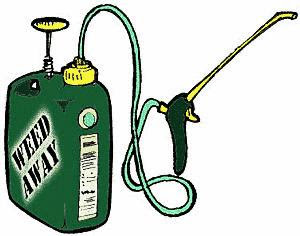A plant is growing fast and strong
Amid the blooms it can't belong.
If you didn't plant it, as seedling or seed,
The chances are, it must be a weed!
 Look! Is that a wildflower or a weed in your garden? It can be tricky to tell.
Look! Is that a wildflower or a weed in your garden? It can be tricky to tell.
Exactly what is a weed?
Basically, a weed is anything that voluntarily or suddenly appears in your cultivated garden or lawn areas. You can spot these unwelcome plants quite easily. Weeds are the ones that seem to pop up in your garden and grow much faster than anything out there!
Common Weeds
Chickweed, an annual weed, forms dense mats in the garden with shallow roots. Bright green leaves and small white star-like flowers are the keys to identifying this intruder. Chickweed seeds itself and spreads out with its creeping stems.
Curled dock, a buckwheat relative, is marked by its fleshy rosette-like foliage and its rust-colored taproot. The dark green heart-shaped leaves of this weed have frilly edges. The flowers are usually yellow, and they dry into a rusty fruit.
Dandelions, perhaps the most pervasive weeds, are also the simplest to recognize in the garden. The lobe-like leaves and bright yellow flowers may be spotted throughout the countryside from early May through the summer months. As the flowers dry into fluffy fly-aways, the wind-dispersed seeds repopulate elsewhere.
Knotweed usually appears in grassy areas, but this weed may encroach upon garden beds as well. This grassy weed has dark green leaves, which form a flat mat. Purple buds open into yellow or white flowers in midsummer.
Mallow can be an annual or perennial weed. Round or heart-shaped leaves are usually 2" to 3" wide. Flowers may be white with purple accents. Mallow produces flat disk-like fruit.
Mints and root ivies may appear lovely, but they are extremely invasive in the garden, much like weeds. Mint or ivy leaves may be round, heartlike, or kidney-shaped. They may be smooth, viney, rippled, or ridged. The roots may burrow horizontally under the ground, with new colonies popping up in unexpected places of your yard or garden. Most varieties of mints and ivies do produce flowers, which propagate through seeding.
Plaintains are cool-season perennial weeds. Their curly and veiny leaves naturally form rosettes. From May to October, plaintains may flower, with tall stalks of tiny blossoms. This weed reproduces by seeding itself and spreading roots.
Purslane, a summer annual weed, is marked by fleshy purplish leaves and stems. Purslane boasts five-petaled yellow flowers in midsummer. This weed multiplies by seeding itself.
Thistles are biennial weeds that reproduce by seeding themselves. These spiny-leaved weeds are extremely aggressive. From June to October, they may produce large spiny purple flower heads.
Yarrow may be a flower or a weed. The wild weed variety can be quite aggressive in the garden. Flowers may be white, pink, yellow, or other colors. The fern-like foliage and tiny clustered flowers of this weed are distinguishing features.
Wild clover, garlic, strawberries, and violets may look promising, but they can quickly become problematic in the garden.
If you do spot weeds in your garden, or other aggressive plants, you must pull them out by the roots. A fractional root may recover, and the unwelcome weeds vegetation may return with a vengeance!
 You can also spray weeds with a broad-leaf post-emergent herbicide (weed-killer).
You can also spray weeds with a broad-leaf post-emergent herbicide (weed-killer).
Be careful that you do not mist your flowers and other welcome plants when you spray the weeds in your garden.
Related Articles of Interest:
Gardening: Cultivating to Control Weeds
Gardening With Children: Growing Green Thumbs
Wasting Walkway Weeds Without Whacking
Zoned Out – Roars About Chores
Click here for “Which Weed Is Which: Picking Out Intruders Among Your Plantings.”
Do you love poetry? Check out Simply Snickers, a brand-new weekly poetry prompt. Or click here to visit Linda Ann Nickerson’s poetry and humor blog, Nickers and Ink.
Click here to subscribe to an RSS feed for this writer's helpful Helium content. If you wish, click here for a free subscription to this author's online AC content, so you won't miss a single post!



No comments:
Post a Comment